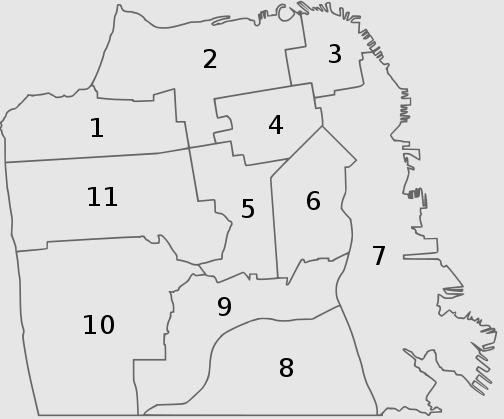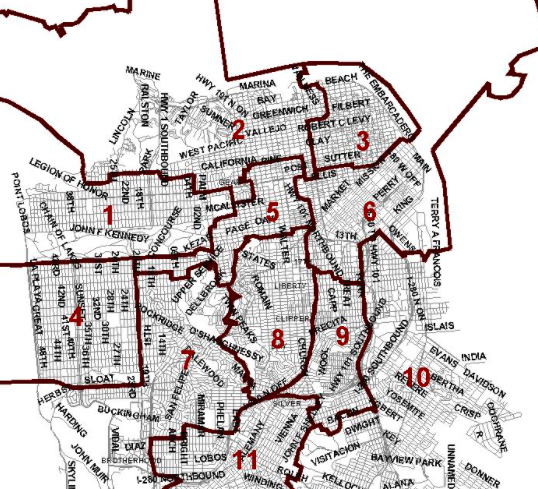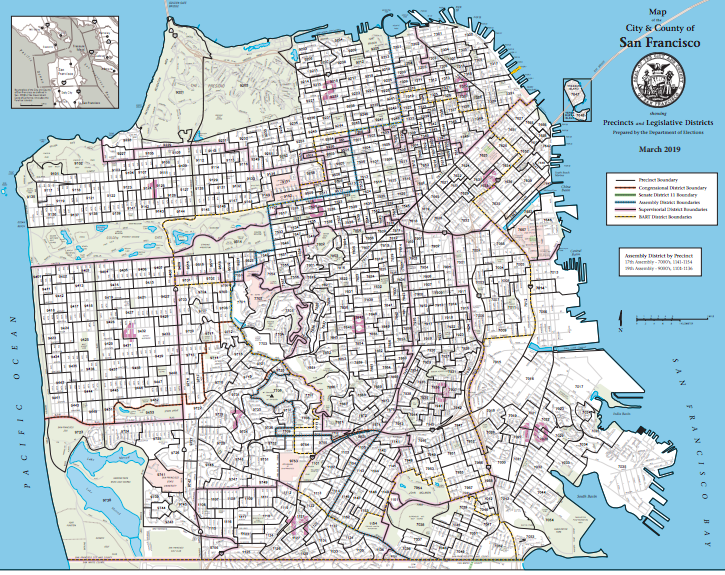A set of crucial decisions that could impact the city’s politics for the next decade are going to start to play out Monday/19 at the Board of Supes Rules Committee – and most of the news media hasn’t even notices.
The committee will recommend three people to serve on the city’s Redistricting Task Force, which will write new lines for the supervisorial districts based on the 2020 census.
This is potentially critical – even small changes in the current lines could have a big political impact.
And the task force will be making more than small changes: The city has picked up 80,000 new residents in the past ten years, most of them on the East Side of town, so some district lines will have to change pretty significantly.
The City Charter calls for a nine-member task force to write the new lines. Three are appointed by the Elections Commission, which has already made its choices. Among them is Ditka Reiner, who is the second signer on the petition to recall Chesa Boudin and is very much in the moderate camp. Ethics records show that appointee Chesal Lee donated to Sonja Trauss for Supervisor, Vallie Brown for Supervisor, and Suzy Loftus for District Attorney and supported London Breed for Mayor. He also backed Mary Jung, the real-estate lobbyist, for DCCC.
I don’t know much about the third person, Raynell Cooper.
But already, we have some people in the anti-progressive camp on the task force.
Then three are appointed by the mayor, who hasn’t made her decisions yet, but I think we know her politics.
Which means the three remaining members, appointed by the Board of Supes, will be critical.
The last time a task force rewrote the lines, ten years ago, not much changed. In fact, the districts that are now in place are not that different from the ones that were set up with the return to district elections in 1995.

Other than the numbers, the districts aren’t radically different from the first district map, drawn in 1977.


But a task force that wanted to undercut progressive power on the board could make some changes that would divide existing constituencies and make it harder for progressives to maintain control of the board.
Imagine, for example, a plan that moved the very conservative areas of Seacliff and Presidio Terrace out of D2 and into D1. A conservative would still control D2, but a progressive would have a harder time in what is already a very close D1.
Or imagine cutting the Tenderloin out of D6 and adding Potrero Hill. Or splitting D8 and D9 so that the North Mission was paired with the Castro and the southern part of the Mission and Bernal Heights were paired with Noe Valley. That would seriously dilute the Latino vote.
The task force is supposed to keep established neighborhood boundaries intact, and there’s no real reason for a massive rewrite. But no matter how you look at it, with the population changes, D6 is going to shrink (lots of new housing in Soma), and the lines around D9, D3, D5 and D8 are going to change. And the lines are going to matter.
San Francisco Rising is actively engaged in the issue right now, and has put forward three candidates for the board slots.
That group has put forward Jeremy Lee, who works for Chinatown Community Development Center, Jose Maria Hernandez Gil, an organizer with SEIU Local 1021, and Michelle Pierce, executive director of Bayview Hunters Point Community Advocates.
“It’s critical to have people on this task force who have a long history of working with communities of color and marginalized people,” Jill Shenker, interim co-director of SF Rising Action Fund, told me.
From the group’s recent email to supporters:
Jose Maria (Chema) Hernandez used to work for SF Rising, lives in SOMA, and has been doing civic engagement work in San Francisco for many years (and spent several years working with SF Rising), with a particular emphasis on Districts 9, 10, and 11. As a bilingual (Spanish/English) indigenous immigrant from Mexico and union organizer, he will ensure working class, immigrant, and Spanish speaking communities are engaged and taken into consideration in the redistricting process. Chema has led many non-partisan civic engagement programs to encourage voter participation and turnout in the Latinx community, conducting doorknocking and phonebanking programs in Spanish to encourage monolingual immigrants to exercise their democratic rights in civic engagement.
Jeremy Lee is a native San Franciscan, gay, Chinese American with deep familiarity and relationships in District 3. He will bring an important perspective about the impacts of redistricting on the 1/3 of San Franciscans who identify as Asian. His work on affordable housing and the needs of low-income Chinese immigrant tenants at the Chinatown Development Community Center demonstrates his commitment and experience working with these communities.
Michelle Pierce would bring critical perspective from her deep connections in the Bayview-Hunters Point neighborhood, where she is the Executive Director of Bayview Hunters Point Community Advocates, whose work focuses on issues of environmental, social and economic justice. Pierce has over 20 years of experience working in sustainability and social justice, including work with the San Francisco Department of the Environment. She is an African American, native San Franciscan, who has lived in the Southeast Corridor of the city all her life.
There are other candidates who have applied for the board slots who have a history with the progressive movement: Polly Marshall is a longtime tenant lawyer and organizer.
Joy Zhan has worked with the Chinese Progressive Association and on Vilaksa Nguyen’s campaign for supervisor.
The three the committee picks (assuming the full board goes along, which is likely) will have to set aside a lot of time over the next year for a complex – and possibly contentious – process.
Most of the work will be done openly, and early drafts of the new districts will be public. So it’s also critical that everyone who cares about the future of the city pay attention, get involved, offer comments – and watch out.
The meeting starts at 10am. Information on how to call in and comment is here.




